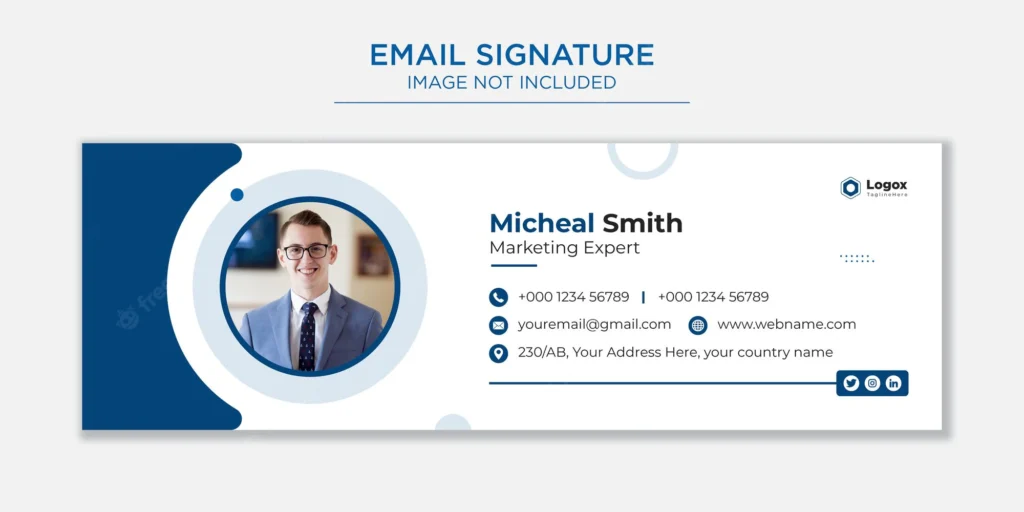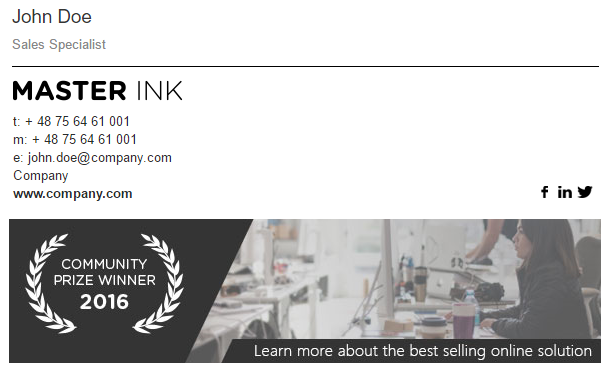Email signatures can seem like such a small part of your brand but they are an important tool in your marketing and communications strategy.
Although the digital world has become increasingly cluttered with new ways to communicate, email still stands as a pillar of digital communications. When you want to speak with someone directly, whether that’s the CEO of a company you hope to work for or a potential customer, email is typically the best way to get someone’s attention and start a relationship. An email is a form of communication that is continuing to grow along with the rest of the digital communications sphere. By 2024 there will be a projected 4.4 billion users of email worldwide.

An example of a good email signature. Image courtesy of Freepik.
If you are looking for an easy way to stand out, improve your branding and get the best out of every email you send, you should be looking into bettering or adding a signature to your email.
Email signatures can be a part of your marketing strategy
ESM stands for email signature marketing. Your signature can be used for much more than just your name and email address. The best part of using email signature marketing is that it’s easy. Adding email signatures to your marketing strategy is a great way to create a cohesive brand image, build rapport over email, and utilize the timeless communication platform.
Email signatures build trust and recognition
A good email signature helps to convey a sense of professionalism and can make your message appear more polished and put together. Signatures can include contact information, pronouns, social media, a photo, and or a company logo. The details in your signature can boost your and your brand’s legitimacy when emailing. When your email appears polished and features contact information it may feel safer to respond to.
Along with building trust, signatures can build brand recognition. Because a signature can include a logo or even a personalized banner, emails continuously reinforce your brand. In this way, your signature can be thought of as your digital business card.

An example of an email signature with a logo and banner. Image courtesy of mailsignatures
Like a business card, a signature should be used to create a cohesive brand image. A good signature should include similar visual details that link you and others to your brand. This small detail in your email can be the finishing touch that will contribute to a concrete brand image.
Email signatures can include points of contact and important links. Signatures provide a simple way to promote social media, websites, or new products without intrusive advertising.

An example of an email signature with a 2D barcode. Image courtesy of mailsignatures
There are multiple ways to increase interaction with your brand such as:
- Banners
- QR Codes
- Links
- Logos
Adding visual elements to your signature allows recipients to further interact with you and your brand.
Signatures can improve communications within your company
Signatures are highly customizable. They are great for getting across a brand’s identity, sharing information, and establishing trust. Signatures can also assist in improving internal communications.
If everyone in a company shares a common signature aspect like a banner, information can easily be shared company-wide. Signatures can be used to communicate many things within a company. Looking to get employees more engaged? Share community activities via email signature. Is a deadline coming up for benefit enrollments or a mandatory app adoption? All of these things can be communicated on a regular basis within email signatures.
In larger companies, email signatures with headshots can create a sense of familiarity between employees.
Properly branded signatures can improve employee advocacy of a brand. If employees share similar signature elements, they can have a hand in advocating for the brand as well. Allowing personalization of aspects like links to projects in different departments can be a great way to turn everyone in a company into a willing advocate.
6 Things to avoid in your email signatures
Email signatures are important, but they can be done poorly. An email signature should be attractive without being distracting or overwhelming. It’s also important to ensure your sending signatures that will appear the same to all recipients. Some things to avoid in your signature:
1. Too much contact information
While it is tempting to list every avenue of contact you use, you should stick to the things you use the most. An email address, phone number, and website usually suffice. If you want to fit in social media links, one or two small icons can make your signature look less busy.
2. Large photos
Large photos may run into issues with certain email platforms or recipients who do not have much space or the bandwidth to download them on their devices.
3. Videos
Although this may be a great way to show personality or advertise, it is likely that most email platforms may not support it. If you want to share a video a link to the video would work better.
4. Quotes
A quote may be a more personable addition, but it doesn’t work for email signatures. When cold emailing or emailing in general you risk creating conflict by highlighting a difference in values. Quotes can also appear busy in a signature.
5. Personal information
Email signatures should be professional. Avoid adding too much information for safety reasons and at the risk of appearing informal. Things like private social media pages should not appear in your professional signature.
6. Out-of-date promotional banners or old accounts
You should keep your signature updated. If there’s a banner that is outdated you should stay on top of changing it. The same goes for accounts linked, and all of the information that could change in your signature.
How to create email signatures
The most basic forms of email signatures can be made within an emailing platform. For more advanced tools like banners, and other graphics there are plenty of low-cost tools and platforms online. Every email signature should include the basics like your name, pronouns, position, company, and some basic contact information like a phone number. A good email signature can improve your brand recognition, establish trust and improve your internal communications. Every brand should consider improving its marketing with a personalized email signature.
If you liked this article you might also like our last article on Email Analytics: 8 Strategies to Boost Performance.
